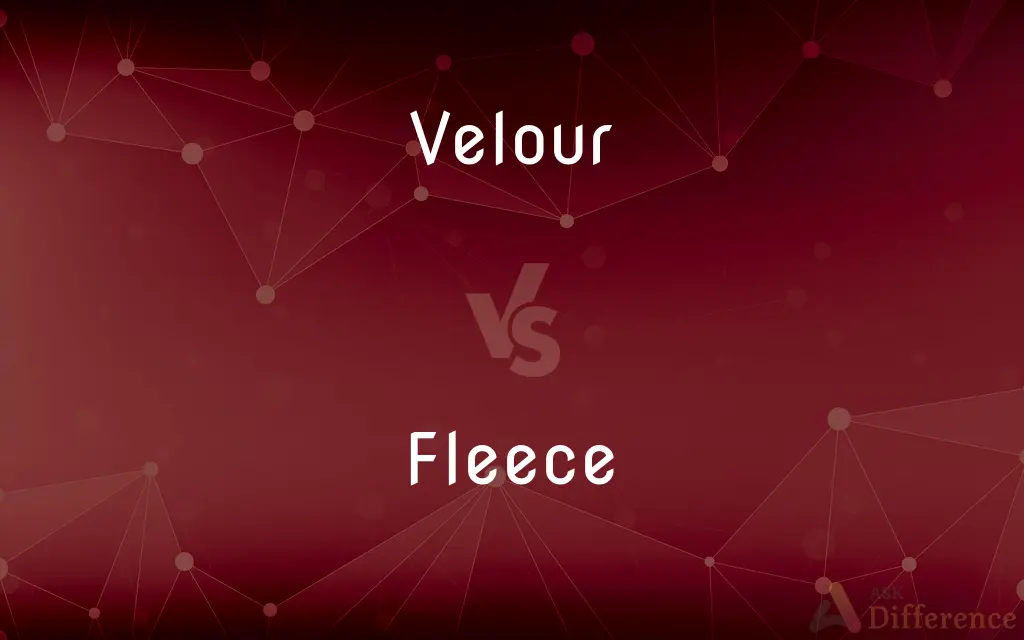Velour vs. Fleece — What's the Difference?
Edited by Tayyaba Rehman — By Fiza Rafique — Updated on October 25, 2023
"Velour" is a plush, knit fabric resembling velvet, often used in upholstery and clothing. "Fleece" is a soft, warm fabric often used for winter clothing, made from synthetic fibers or sheep's wool.

Difference Between Velour and Fleece
Table of Contents
ADVERTISEMENT
Key Differences
Velour and Fleece are both popular textiles in the fashion and upholstery industries, but they differ significantly in texture and use. Velour is a soft, plush, knitted fabric that is similar in feel to velvet. It's often seen in loungewear, tracksuits, and theater curtains. Fleece, on the other hand, is known for its warmth and is a staple for cold-weather garments.
When it comes to the composition, Velour can be made from cotton or synthetic fibers, giving it a luxurious and shiny appearance. Fleece, conversely, is predominantly synthetic, made from polyester, and can also refer to the natural woolly covering of a sheep.
In the world of home interiors, Velour finds its place in upholstery, drapes, and cushions due to its elegant look and soft touch. Fleece, while not as common in home decor, might be used in blankets or as lining material because of its insulating properties.
From a care perspective, Velour often requires a gentle touch, avoiding high temperatures when washing or drying to maintain its soft texture and sheen. Fleece, being more durable and often synthetic, can usually withstand regular washing, though it's also prone to static and pilling.
In summary, while both Velour and Fleece offer a soft texture, the former is more about luxury and sheen, and the latter is all about warmth and comfort.
ADVERTISEMENT
Comparison Chart
Primary Texture
Plush, similar to velvet.
Soft, fluffy, and warm.
Common Uses
Loungewear, upholstery, drapes.
Winter clothing, blankets.
Material Origin
Cotton or synthetic fibers.
Predominantly synthetic; also refers to natural sheep's wool.
Feel & Appearance
Luxurious, with a subtle shine.
Warm, with a more matte appearance.
Care Requirements
Gentle care; sensitive to high temperatures.
Durable; prone to static and pilling.
Compare with Definitions
Velour
A material used in upholstery for its luxurious texture.
The velour seats in the car were extremely comfortable.
Fleece
A material used for insulating garments.
The fleece lining kept her warm.
Velour
A plush, knit fabric resembling velvet.
She wore a velour tracksuit.
Fleece
A textile known for its fluffy texture.
The fleece blanket was soft to the touch.
Velour
A stretchy fabric with a deep pile.
The velour dress fit her perfectly.
Fleece
Fabric that's lightweight yet provides significant warmth.
Despite its weight, the fleece pullover provided ample warmth.
Velour
A cloth that offers a shiny, velvety appearance.
Her velour jacket shimmered in the light.
Fleece
The woolly covering of a sheep or goat
He clutched the ram by two handfuls of thick fleece
As the sheep came on board, we grabbed their long shaggy fleeces
Velour
A textile with a soft, smooth surface.
The velour curtains added elegance to the room.
Fleece
A soft warm fabric with a texture similar to sheep's wool, used as a lining material
A reversible fleece jacket
Velour
Velour or velours is a plush, knitted fabric or textile similar to velvet or velveteen. It is usually made from cotton, but can also be made from synthetic materials such as polyester.
Fleece
Obtain a great deal of money from (someone), typically by overcharging or swindling them
The city's cab drivers are notorious for fixing fares and fleecing tourists
Velour
A closely napped fabric resembling velvet, used chiefly for clothing and upholstery.
Fleece
Cover as if with a fleece
The sky was half blue, half fleeced with white clouds
Velour
A felt resembling velvet, used in making hats.
Fleece
The coat of wool of a sheep or similar animal.
Velour
A knit fabric similar to velvet, but usually somewhat coarser.
Fleece
The yield of wool shorn from a sheep at one time.
Velour
Heavy fabric that resembles velvet
Fleece
A soft woolly covering or mass.
Fleece
A soft, warm, lightweight, usually synthetic fabric with a deep pile, used primarily for clothing and blankets.
Fleece
A garment, especially a shirt or jacket, made of such fabric.
Fleece
To defraud of money or property; swindle.
Fleece
To shear the fleece from.
Fleece
To cover with a fleece or similar covering.
Fleece
(uncountable) Hair or wool of a sheep or similar animal
Fleece
(uncountable) Insulating skin with the wool attached
Fleece
(countable) A textile similar to velvet, but with a longer pile that gives it a softness and a higher sheen.
Fleece
(countable) An insulating wooly jacket
Fleece
(roofing) Mat or felts composed of fibers, sometimes used as a membrane backer.
Fleece
Any soft woolly covering resembling a fleece.
Fleece
The fine web of cotton or wool removed by the doffing knife from the cylinder of a carding machine.
Fleece
(transitive) To con or trick (someone) out of money.
Fleece
(transitive) To shear the fleece from (a sheep or other animal).
During spring shearing we have to fleece all the sheep in just a few days.
Fleece
(transitive) To cover with, or as if with, wool.
Fleece
The entire coat of wool that covers a sheep or other similar animal; also, the quantity shorn from a sheep, or animal, at one time.
Who shore meLike a tame wether, all my precious fleece.
Fleece
Any soft woolly covering resembling a fleece.
Fleece
The fine web of cotton or wool removed by the doffing knife from the cylinder of a carding machine.
Fleece
To deprive of a fleece, or natural covering of wool.
Fleece
To strip of money or other property unjustly, especially by trickery or fraud; to bring to straits by oppressions and exactions.
Whilst pope and prince shared the wool betwixt them, the people were finely fleeced.
Fleece
To spread over as with wool.
Fleece
The wool of a sheep or similar animal
Fleece
Tanned skin of a sheep with the fleece left on; used for clothing
Fleece
A soft bulky fabric with deep pile; used chiefly for clothing
Fleece
Outer coat of especially sheep and yaks
Fleece
Rip off; ask an unreasonable price
Fleece
Shear the wool from;
Shear sheep
Fleece
A soft fabric made from synthetic fibers, known for warmth.
He wore a fleece jacket in the cold.
Fleece
The woolly covering of a sheep.
Shearing collects the fleece from the sheep.
Common Curiosities
Is Velour similar to velvet?
Yes, Velour is plush like velvet but is knitted.
Can both Velour and Fleece be used for jackets?
Yes, Velour for style and Fleece for warmth.
Is Velour stretchy?
Typically, Velour has some stretch, making it fit comfortably.
What's the main purpose of Fleece in clothing?
Fleece is primarily used for insulation and warmth.
Which is shinier, Velour or Fleece?
Velour usually has a subtle shine, while Fleece is more matte.
Is Fleece breathable?
Not as much as other fabrics; Fleece is designed to retain heat.
Is Fleece good for summer clothing?
Not typically; Fleece is better suited for colder climates.
Can Fleece be a natural material?
Yes, it can refer to sheep's wool, but often it's synthetic.
Can Velour be used in home decor?
Yes, Velour is often used in upholstery and drapes.
Can you use Fleece for elegant evening wear?
Rarely. Fleece is casual, while Velour might be used for elegant wear.
Which is softer to the touch?
Both are soft, but Velour has a smoother feel, while Fleece is fluffy.
Between Velour and Fleece, which is better for sportswear?
Fleece is commonly used for sportswear due to its insulating properties, while Velour is more for style and comfort.
Can Velour be made from synthetic materials?
Yes, Velour can be made from both natural and synthetic fibers.
Is Fleece prone to pilling?
Yes, especially synthetic Fleece can pill over time.
Is Velour durable?
While comfortable, Velour might not be as durable as Fleece.
Share Your Discovery

Previous Comparison
Curate vs. Vicar
Next Comparison
Allah vs. KrishnaAuthor Spotlight
Written by
Fiza RafiqueFiza Rafique is a skilled content writer at AskDifference.com, where she meticulously refines and enhances written pieces. Drawing from her vast editorial expertise, Fiza ensures clarity, accuracy, and precision in every article. Passionate about language, she continually seeks to elevate the quality of content for readers worldwide.
Edited by
Tayyaba RehmanTayyaba Rehman is a distinguished writer, currently serving as a primary contributor to askdifference.com. As a researcher in semantics and etymology, Tayyaba's passion for the complexity of languages and their distinctions has found a perfect home on the platform. Tayyaba delves into the intricacies of language, distinguishing between commonly confused words and phrases, thereby providing clarity for readers worldwide.














































